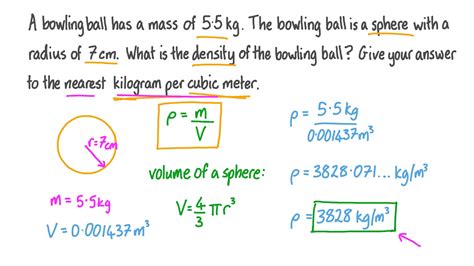In the realm of physics, understanding the density of an object is crucial for comprehending its mass and volume characteristics. When it comes to three-dimensional objects, such as spheres, calculating density becomes essential for various scientific applications and engineering endeavors. This article delves into the intricacies of density formula for spheres, providing a comprehensive guide to its understanding and utilization.

Defining Density
Density, denoted by the symbol ρ (Greek letter rho), is a fundamental property of matter that quantifies the mass (m) of a substance per unit volume (V). It is expressed in kilograms per cubic meter (kg/m³). The higher the density, the more mass is packed into a given volume.
Density Formula for Sphere
For a sphere, the density formula is given by:
ρ = m / (4/3)πr³
where:
– ρ is the density (kg/m³)
– m is the mass of the sphere (kg)
– r is the radius of the sphere (m)
– π is a mathematical constant approximately equal to 3.14
Applications of Density Formula for Spheres
The density formula for spheres finds applications in a wide range of fields, including:
- Astrophysics: Determining the mass and density of celestial bodies, such as planets, stars, and moons.
- Engineering: Designing spherical components for machinery and structures, ensuring optimal strength and durability.
- Materials Science: Characterizing the density of materials to evaluate their porosity, purity, and composition.
- Medicine: Calculating the density of biological tissues for diagnostic purposes, such as detecting abnormalities in organs.
Practical Applications of the Density Formula for Spheres
Beyond its scientific and engineering uses, the density formula for spheres also has practical applications in everyday life:
- Sports: Determining the weight and buoyancy of balls used in sports such as basketball, soccer, and tennis.
- Transportation: Optimizing the design of spherical wheels for vehicles to achieve desired performance and fuel efficiency.
- Agriculture: Measuring the density of fruits and vegetables to assess their ripeness and quality.
Exploring the Concept of “Sphericity”
The concept of “sphericity” is closely tied to the density formula for spheres. Sphericity refers to the degree to which an object approximates a perfect sphere. The closer an object is to being a perfect sphere, the more accurate the density formula becomes.
Benefits of Using the Density Formula for Spheres
Utilizing the density formula for spheres offers several advantages:
- Accuracy: Provides a precise method for determining the density of spherical objects.
- Simplicity: The formula is straightforward and easy to apply, requiring only the measurement of mass and radius.
- Applicability: Can be used for a wide range of materials, including solids, liquids, and gases.
Tips for Accurate Density Calculations
To ensure accurate density calculations using the formula, consider the following tips:
- Accurately measure the mass of the sphere using a calibrated scale.
- Determine the radius of the sphere with precision using appropriate measuring tools or techniques.
- Ensure that the sphere is as close to a perfect sphere as possible to minimize errors.
Density Table of Common Materials
The following table provides a reference of density values for various common materials:
| Material | Density (kg/m³) |
|---|---|
| Water | 1000 |
| Steel | 7850 |
| Aluminum | 2700 |
| Wood | 500-1200 |
| Helium | 0.1786 |
Impact of Temperature and Pressure on Density
It is important to note that the density of a substance can vary with changes in temperature and pressure. In general, the density of solids and liquids decreases with increasing temperature, while the density of gases increases.
Density Formula for Hollow Spheres
For hollow spheres, where the material is distributed in a spherical shell, the density formula is slightly modified:
ρ = (m / (4/3)π(r³ – r₁³))
where:
– r₁ is the inner radius of the spherical shell
Conclusion
The density formula for spheres is a fundamental tool in understanding the physical properties of spherical objects. Its applications span across scientific disciplines and everyday life, providing valuable insights into the mass, volume, and composition of matter. By accurately measuring the mass and radius of a sphere, scientists and engineers can precisely calculate its density, enabling them to optimize designs, assess materials, and advance our understanding of the world around us.
